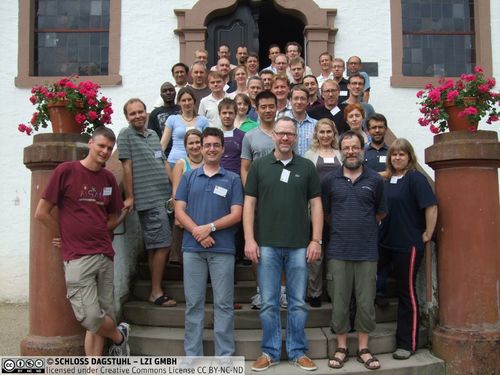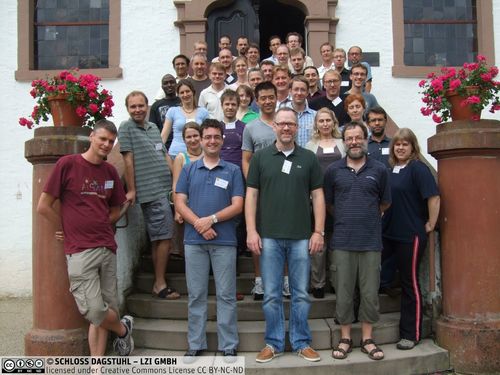Dagstuhl-Seminar 11341
Learning in the context of very high dimensional data
( 21. Aug – 26. Aug, 2011 )
Permalink
Organisatoren
- Michael Biehl (University of Groningen, NL)
- Barbara Hammer (Universität Bielefeld, DE)
- Erzsébet Merényi (Rice University - Houston, US)
- Alessandro Sperduti (University of Padova, IT)
- Thomas Villmann (Hochschule Mittweida, DE)
Kontakt
- Simone Schilke (für administrative Fragen)
Rapidly increasing sensor technology, greatly enhanced storage capabilities, and dedicated data formats have lead to a dramatic growth of the size of electronic data available today and, even more so, its dimensionality. Examples include diverse formats such as spectral data, micro-\ and macroarrays, biotechnological sequence data, or high resolution digital images. Due to its dimensionality and complexity, these data sets can hardly be addressed by classical statistical methods; nor do standard presentation and visualization tools allow an adequate direct inspection by humans. Thus, the need for efficient and reliable automatic processing and analysis tools for very high dimensional data arises in different areas such as bioinformatics, medicine, multi-band image analysis, robotics, astrophysics, geophysics, etc.
The aim of the seminar was to bring together researchers who develop, investigate, or apply machine learning methods for very high dimensional data to advance this important field of research. The focus was put on broadly applicable methods and processing pipelines which offer efficient solutions for high-dimensional data analysis appropriate for a wide range of application scenarios.
39 experts from 12 different countries joined the seminar, including a good mixture of established scientists and promising young researchers working in the field. Thereby, the special interests of the researchers ranged from dedicated algorithmic design connected to diverse areas such as dimensionality reduction, data visualization, metric learning, functional data analysis, to various application scenarios including diverse areas such as the biomedical domain, hyperspectral image analysis, and natural language processing.
This setup allowed us to discuss salient issues in a way that integrated perspectives from several points of views and scientific approaches, thereby providing valuable new insights and research contacts for the participants. Correspondingly, a wide range of topics was covered during discussions and presentations in the seminar.
Altogether, the seminar opened quite a few perspectives pointing into important research directions in the context of very high dimensional data.
- Gyan Bhanot (Rutgers University - Piscataway, US) [dblp]
- Michael Biehl (University of Groningen, NL) [dblp]
- Kerstin Bunte (Universität Bielefeld, DE) [dblp]
- Gert-Jan de Vries (Philips Research Lab. - Eindhoven, NL) [dblp]
- Klaus Dohmen (Hochschule Mittweida, DE)
- Richard Farkas (University of Szeged, HU) [dblp]
- Tina Geweniger (University of Groningen, NL) [dblp]
- Andrej Gisbrecht (Universität Bielefeld, DE) [dblp]
- Sven Haase (Hochschule Mittweida, DE)
- Barbara Hammer (Universität Bielefeld, DE) [dblp]
- Marika Kästner (Hochschule Mittweida, DE)
- Arto Klami (Aalto University, FI)
- Neil D. Lawrence (University of Sheffield, GB) [dblp]
- John Aldo Lee (University of Louvain, BE) [dblp]
- Marco Loog (TU Delft, NL)
- Thomas Martinetz (Universität Lübeck, DE) [dblp]
- Erzsébet Merényi (Rice University - Houston, US) [dblp]
- Bassam Mokbel (Universität Bielefeld, DE) [dblp]
- Ernest Mwebaze (Makerere University - Kampala, UG)
- Oliver Obst (CSIRO - Marsfield, AU)
- Vladimir Pestov (University of Ottawa, CA)
- John Quinn (Makerere University - Kampala, UG) [dblp]
- Fabrice Rossi (University of Paris I, FR) [dblp]
- Frank-Michael Schleif (Universität Bielefeld, DE) [dblp]
- Petra Schneider (University of Birmingham, GB) [dblp]
- Udo Seiffert (Fraunhofer IFF - Magdeburg, DE) [dblp]
- Diego Sona (Bruno Kessler Foundation - Trento, IT)
- Marc Strickert (Universität Marburg, DE) [dblp]
- Kadim Tasdemir (EC Joint Research Centre - Ispra, IT)
- David M. J. Tax (TU Delft, NL)
- Peter Tino (University of Birmingham, GB) [dblp]
- Laurens van der Maaten (TU Delft, NL) [dblp]
- Jort van Mourik (Aston University - Birmingham, GB)
- Marina Vanucci (Rice University - Houston, US)
- Michel Verleysen (University of Louvain, BE) [dblp]
- Thomas Villmann (Hochschule Mittweida, DE) [dblp]
- Kilian Weinberger (Washington University - St. Louis, US) [dblp]
- Xibin Zhu (Universität Bielefeld, DE)
- Dietlind Zühlke (Fraunhofer Institut FIT - St. Augustin, DE) [dblp]
Klassifikation
- Artificial intelligence
- soft computing
Schlagworte
- Curse of dimensionality
- dimensionality reduction
- regularization
- deep learning
- visualization



